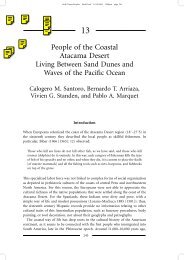Late Quaternary History of the Atacama Desert.
Late Quaternary History of the Atacama Desert.
Late Quaternary History of the Atacama Desert.
Create successful ePaper yourself
Turn your PDF publications into a flip-book with our unique Google optimized e-Paper software.
76 part one environmental historyThe Arequipa record, described in Holmgren et al. (2001), incorporatesmiddens found between 2350 and 2850 metres <strong>of</strong> elevation. The majority weremade by leaf-eared mice and chinchilla rats although a few were also made bymountain viscachas. Overall, <strong>the</strong> Arequipa midden record is remarkably stableover <strong>the</strong> last 9500 years (all ages are quoted as cal. BP, calibrated radiocarbonages) (Figs 6.1a and 6.1b). At lower elevations, middens between 9500 and 7400years ago have remarkably low numbers <strong>of</strong> annuals, grasses and perennialsas well as a low total number <strong>of</strong> taxa (10 and under). These taxa experience athreefold increase at 6700 years cal. BP, with annuals increasing from threeto nine taxa, and <strong>the</strong> total number <strong>of</strong> taxa rising to 26. O<strong>the</strong>r mid-Holocenemiddens are also characterised by a rich assemblage <strong>of</strong> annuals until 3800years cal. BP. Middens from <strong>the</strong> late Holocene date between 1300 cal. BP and<strong>the</strong> present, and are slightly poorer in annuals and perennials when comparedto mid-Holocene ones. The numbers <strong>of</strong> cacti remain surprisingly constantthroughout <strong>the</strong> record, diminishing only slightly in <strong>the</strong> early Holocene.Middens above 2600 metres show somewhat greater vegetation stability.Most <strong>of</strong> <strong>the</strong> middens have between 15 and 20 taxa. Those dated between4000 and 3400 years ago, however, have fewer grasses and only 10 to 11 taxa.Middens younger than 700 cal. BP have <strong>the</strong> largest numbers <strong>of</strong> annuals andperennials. Cacti again remain remarkably constant. Of note in this series is<strong>the</strong> presence <strong>of</strong> Stipa ichu (a steppe grass) and Opuntia ignescens (a cushioncactus), between 5000 to 4500 years ago. Both species now occur 450 and 750metres higher than <strong>the</strong> midden sites.O<strong>the</strong>r late <strong>Quaternary</strong> records from <strong>the</strong> nor<strong>the</strong>rn <strong>Atacama</strong> includeHolocene lake level changes at Lago Aricota in sou<strong>the</strong>rn Peru (17°22'S) andgroundwater fluctuations recorded in terraced spring deposits throughoutnor<strong>the</strong>rnmost Chile. Radiocarbon dates <strong>of</strong> shoreline deposits at Lago Aricotaindicate a maximum highstand (more than eight metres above <strong>the</strong> pre-dam1955 lake level) between more than 7100 to 2800 years ago, with a minorhighstand dated to 1700 to 1300 years ago (Placzek et al. 2001). Fossil springand wetland deposits, which are located around modern springs and wetlands,are common surficial deposits in <strong>the</strong> <strong>Atacama</strong> <strong>Desert</strong>. These deposits generallyconsist <strong>of</strong> alluvial silt and sand, diatomite, organic mats and tufa. Wetlanddeposits from four separate hydrologic settings were studied to reconstruct
















